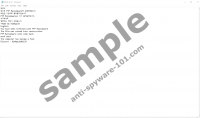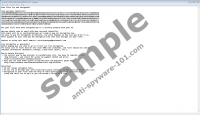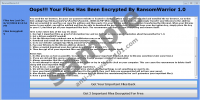Crypt6 Ransomware is a malicious program that can encrypt various user’s files and then show a warning claiming the user has to pay for decryption. Since the ransom note is in French and the infection does not provide a means to translate it, we believe the threat’s creators could be targeting users who speak the French language only. This might mean the malware may not be distributed widely. In any case, if you did encounter it, we would recommend reading our full report to get to know Crypt6 Ransomware better. Further in the text, we will talk about its possible distribution channels, working manner, and ways it could be erased from the system. More than that, if you slide a bit below the article, you will find deletion instructions explaining how to eliminate this infection manually step by step. Read more »
Monthly Archives: August 2018
Zoldon Ransomware
Do you know what a file-encryptor is? It is an infection that encrypts files. Zoldon Ransomware is not an infection capable of doing that, although it ties to trick victims into thinking that it is. At best, it is a screen-locker, but it fails at that also. According to Anti-Spyware-101.com researchers, it is possible to close the window via the Task Bar or the Task Manager to inspect the allegedly corrupted files. This step is exceptionally important because you want to see what damage was or was not done before you pay attention to the demands that cyber criminals have. If you check your files, it should become obvious very quickly that your personal files are fine and that you do not need to worry about permanent encryption. That being said, even if your files are not encrypted, you want to remove malware that has invaded your operating system. We have a few useful tips for you that will help delete Zoldon Ransomware from the Windows operating system with ease. Read more »
Exerciers.mobi
It can be really dangerous to interact with online advertisements that come your way, especially if they are delivered via Exerciers.mobi and other unreliable adware servers. Adware, as you know, stands for advertising-supported software, but in this situation, it is unlikely that the server needs applications or extensions to act. Of course, it is possible that adware active on your operating system and browser is connecting to the server and delivering ads hosted on it, but it is also possible that you have activated the suspicious ads yourself by agreeing to see notifications. Do you remember enabling notifications when you visited a suspicious website? If you have, you might find yourself needing to delete Exerciers.mobi ads. Is that feasible? It certainly is, and the removal guide available below should help you. First, of course, we suggest performing a full system scan to check if you need to erase adware-server related software or other infections. Read more »
ERROR #268d3x8938 pop-ups
ERROR #268d3x8938 pop-ups are fake system alerts, so if you see one, you should not trust it. Our researchers believe the warning might be prepared by hackers who may seek to scam their victims over the phone since the message should ask the user to call 1-855-624-0192. The mentioned telephone alone should show it is a scam because Microsoft does not have a helpline; instead, users can contact the support by visiting the official company’s web page. Therefore, users who notice ERROR #268d3x8938 pop-ups on their browser should eliminate them at once with no hesitation. If you have no idea how to get rid of it, you could check the instructions available at the end of this article. However, if you came here to learn about this threat as well, you may want to read the rest of the text too. Read more »
PTP Ransomware
If you live in Korea, PTP Ransomware is an infection you need to put on your radar. At the time of analysis, Anti-Spyware-101.com research team determined that the infection was not fully developed or was buggy, which indicates that it is not a real danger yet. That being said, a new, more powerful version could be released at any point, and you might already be dealing with a fully functional version of this malware by the time you are reading this report. The information gathered by our malware researchers helped us to determine that the infection was created to encrypt files, but it is not yet clear whether or not it would ever be spreading in the wild. If this is conformed, the report will be updated to provide you with the latest information. For now, let’s discuss the potential of the threat and its removal. If you are interested in learning how to delete PTP Ransomware manually or with the help of software, this is the article for you. Read more »
Servicedeskpay@protonmail.com Ransomware
Ransomware does not stop, and ransomware creators do not sleep. The newest infection to join the ever-growing family is Servicedeskpay@protonmail.com Ransomware, and it is just as bad as it sounds. While there are quite a few fake file-encryptors circulating the web these days – and that is because even the amateurs are now trying to build ransomware – this one is not fake. In fact, it is so real that it will encrypt every single personal file if it stored in the right place. According to Anti-Spyware-101.com research team, the infection does not corrupt system files, but audio, video, image, and text files are a prime target. Once encrypted, these files are paralyzed, so to speak. You cannot open them, and you cannot decrypt them using regular free decryptors. Maybe a reliable decryptor will be created in the future, but, for the time being, it does not exist, and that means that you have nowhere to go with your problem. Surely, the removal of the infection is on your mind, but you might be preoccupied with the fact that your files might be lost. Despite your anguish, it is important to delete Servicedeskpay@protonmail.com Ransomware as soon as possible, and you can learn how to achieve that by reading this report. Read more »
Jigsaw-Dat Ransomware
Jigsaw-Dat Ransomware is to blame if your files are encrypted and have .dat extension. This malicious application was created for money extortion, so by enciphering user’s data, it takes it as a hostage and to receive a ransom the cybercriminals leave a note asking to pay for decryption tools. Unfortunately, there is no way to know if the hackers will hold on to their word and allow you to decrypt your files after paying a ransom. Therefore, we advise not to gamble with your savings. Users who choose to erase it could follow the instructions available at the end of this article. Nevertheless, if you need more information before making your decision, you should keep reading this text and learn more about Jigsaw-Dat Ransomware. Read more »
anonimus.mr@yahoo.com Ransomware
anonimus.mr@yahoo.com Ransomware is a malicious program that shows a message called a ransom note asking to email the threat’s developers if the victim wishes to purchase decryption tools. Such tools might be needed to unlock data encrypted by the malware; otherwise, it becomes useless. Obviously, if you have backup copies and can replace enciphered files with them, there is no need to worry. In such case, we would recommend deleting anonimus.mr@yahoo.com Ransomware with no hesitation. In fact, we advise the same even if you do not have the means to recover your files. Sadly, making the payment does not guarantee the promised tools will be delivered. To remove the threat manually users could check the instructions available at the end of this page. As for further information about it, we encourage you to read our full article. Read more »
RansomWarrior 1.0 Ransomware
RansomWarrior 1.0 Ransomware is a tool for money extortion. If you ever come across this malicious application, you might lose your personal files in just a couple of moments. Our researches report the malware may start encrypting user’s data shortly after infecting the device. Then, the threat should reveal its presence by displaying a message explaining what happened to the targeted files and how the user can recover them by paying a ransom. However, there is hope it might be possible to restore enciphered data without transferring the money to the malicious application’s developers as specialists say the malware might be decryptable. In which case, it could be only a matter of time till volunteer IT specialists prepare a free decryption tool. Besides, all encrypted files can be recovered from backup copies, so if you did make a backup for such emergencies, you might have nothing to worry about. Naturally, for more information about this infection, we encourage you to read the rest of this text. Also, if you decide to remove RansomWarrior 1.0 Ransomware, you could use the instructions located below this article. Read more »
NSB Ransomware
NSB Ransomware is a troublesome file-encrypting threat because it not only ruins the user’s data but also locks his screen. As a consequence, the user cannot access the computer. Our specialists say users can get rid of the locked screen if they restart the computer in Safe Mode and remove the malicious program. Sadly, the files will remain to be enciphered even if the malware is no longer on the system. Therefore, some users might consider paying to hackers since the message they leave behind states that all will go back to normal soon after the victim pays them a particular amount of Bitcoins. What is interesting is the hackers are trying to convince their victims that they have broken specific laws and they ask to pay not a ransom, but a fine. Nevertheless, we do not think many users might fall for such a scam. Those of you who have no intention to put up with any demands could erase NSB Ransomware while looking at the deletion instructions located at the end of this page. However, if you would prefer to get to know the malware better first, you should read the rest of this article. Read more »






